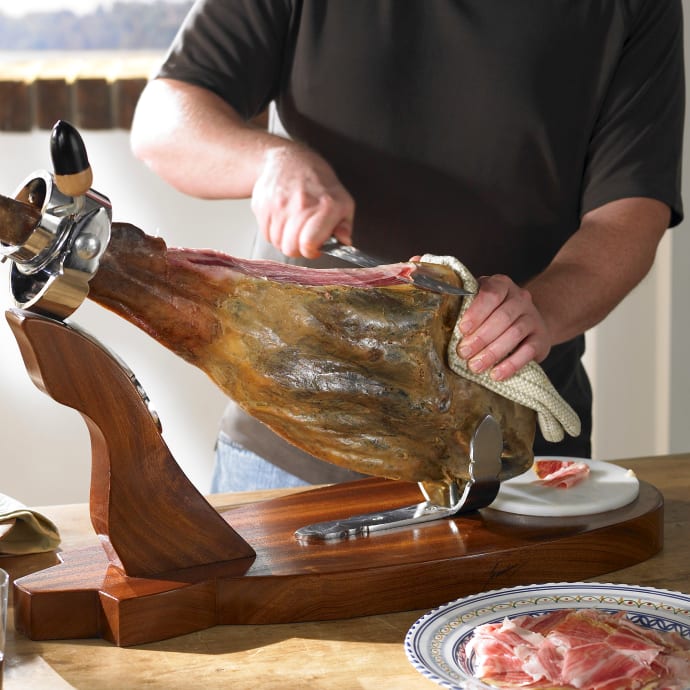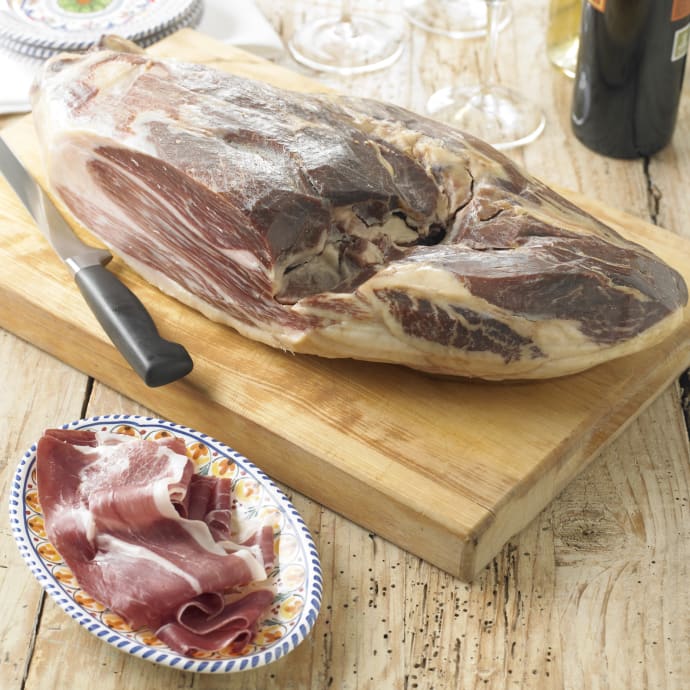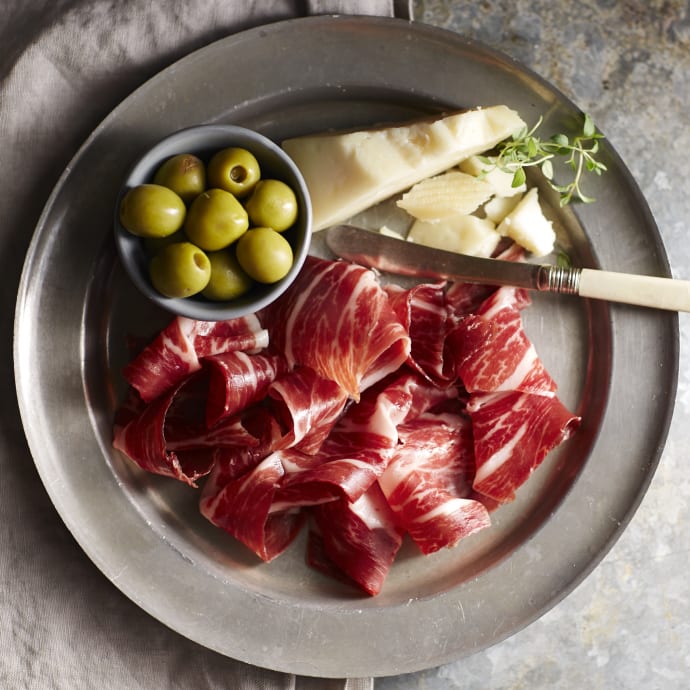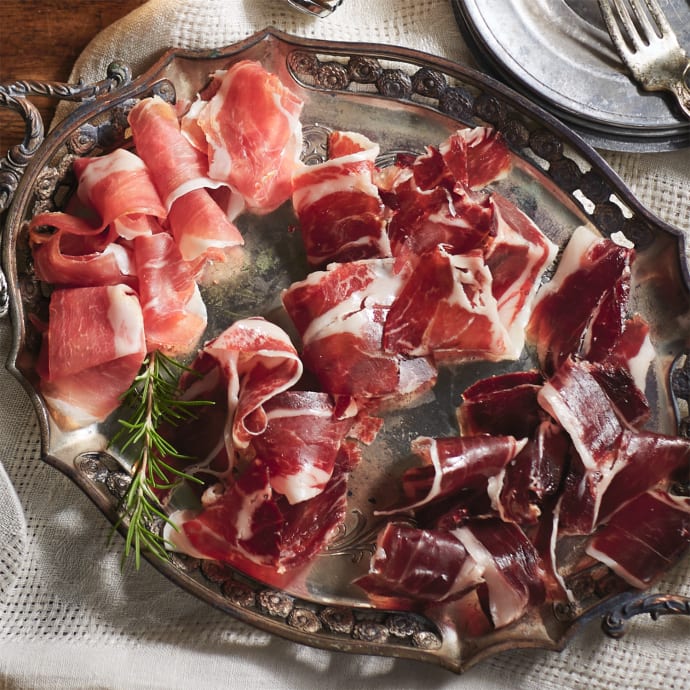
How I got busted -- for harboring ham
The Chicago Tribune
-
May 24, 2005
by Monica Eng - Tribute Staff reporter
So there I was at O'Hare, sleepily waiting to clear customs after a long flight from Spain, when that darn beagle came along and ruined everything.
Barking and lunging at my canvas bag, the four-legged showoff was followed by a customs agent who asked if I was packing any fruit or meat.
"Just some Spanish ham and cheese," I said, innocently.
"I am sorry but you are not allowed to bring in any pork products to the U.S. from Spain," she said. "You are going to have to give me the ham."
Still in a state of shock -- while the dog sat beaming and waiting for praise -- I dug into my bag and pulled out the fragrant waxed paper package bought at Madrid's Museo del Jamon (Museum of Ham) just that morning for $50. I breathed in one last whiff of the smoky, nutty, buttery aroma that characterizes this cured ham carved from only the finest, acorn-fed Iberian pigs.
Then I handed the jamon Iberico de bellota over to the authorities.
In all my years of bringing back edible treasure from abroad, this was my first run-in with the law. And thus my introduction to the ever-changing rules of the Animal and Plant Health Inspection Services.
In general, APHIS permits select produce and meats into the U.S. from certain foreign lands, but Spanish swine is totally off limits. That's because Spain, unlike some other European countries, does not host a single slaughterhouse that has yet been certified by the USDA.
Virginia-based Spanish food importer Jonathan Harris, however, is working to change that. In an effort to decriminalize this ham habit, he's working with a Spanish meat outfit called Covap on a custom-built plant in Pozoblanco, Spain, that is due for inspection by the USDA this fall. If everything checks out, he hopes to import Jamon Iberico to the States by 2007 or 2008.
In the meantime, however, the U.S. continues to view Spanish meat products as risks for swine fever and foot-and-mouth disease. Consequently, it's illegal for individuals to try to import any meats from Spain, even vacuum-sealed packages of it. In fact, according to the Animal Protection Act, I could have potentially faced a $50,000 fine or 10-year jail sentence.
Although she has never seen someone do actual jail time for food trafficking, Agriculture Inspections Chief for the Port of Chicago Marie Martin takes ham hiding seriously. Her division used to fall under the auspices of the United States Department of Agriculture. Today it's a part of the Department of Homeland Security.
During her 17 years in the business, Martin has seen "just about everything" pass through O'Hare.
When asked for specifics, she rattles off the statistics from this past December at the airport where her crew confiscated roughly 4,000 pounds of outlawed meat and oversaw 3,183 seizures of fruits, vegetables and plants.
When asked about interceptions of dangerous unpasteurized cheeses, Martin re-sponded, disappointingly, "We don't seize a lot of cheese."
Getting back to my case, I asked Martin just what my options were. For example, could I have just started stuffing slices of the ham in my mouth?
"Consumption on the spot is not necessarily illegal," she said. "but we would have tried to keep the situation under control. And because the ham is so salty, I think you might have regretted it for the rest of your life."
While many angry foodies envision their confiscated goods ending up at weekly lavish feasts in the customs workers' break room, Martin insists that the seized items are incinerated -- some after a risk assessment.
Harris says he has heard every jamon sob story and smuggling trick in the book.
"One guy wrote in to tell us he was fined $1,000 for bringing it in," Harris said. "And we've heard every strategy for getting it past customs, from putting it in the baby's bag to mailing it with the label 'adult material' to putting a decoy sausage on top of the bag and then the good stuff on the bottom."
Martin admits that, much as her department tries, with more than a million passengers streaming through O'Hare each year, they can't snag everything. But she is neither impressed nor amused by the pork- smuggling tricks.
"We are clued into these [strategies] and they are poor advice," she says more than a little annoyed. "These kinds of violations are where you get into those larger fines and it is really not worth it. You may get a ham through this time but eventually you will get caught."
So is a package of this fat-marbled treasure really worth becoming a Homeland Security target for the rest of your life?
Of course not. So my advice is to pig out on as much jamon as you can while in Iberico friendly zones. And then just try to erase its exquisite memory from your brain.
- - -
What you need to know
When it comes to bringing in restricted items, Agriculture Inspections Chief Marie Martin says ignorance is no excuse.
Certain agricultural items are forbidden because of the fear they could carry pests and diseases, according to the U.S. Customs and Border Protection agency.
Because customs rules change all the time, Martin advises any traveler thinking about toting food back to the States to contact the Animal and Plant Health Inspection Service office at 301-734- 3277, or visit the Web site: www.cbp.gov/xp/cgov/travel/ clearing(unde rscore)goods/ agri(underscore)prod(underscore)inus.xml.
In short, here's what you need to know:
- All travelers entering the U.S. must declare meats, fruits, vegetables, plants, seeds, animals, and plant and animal products (including soup or soup products) they may be carrying.
- Depending on the country of origin, some fruits, vegetables and plants may be brought into the United States without advance permission, if they are declared, inspected and found free of pests.
- Fresh, dried, or canned meats and meat byproducts are prohibited entry into the United States from most foreign countries because of the continuing threat of foot-and-mouth disease, bovine spongiform encephalopathy (mad cow disease), and other animal diseases. Still, whole legs of Italy's prosciutto di Parma, for instance, trot in with travelers each year as long as they are accompanied by proper docu-mentation regarding their processing.
- Hunting trophies, game animal carcasses, and hides are severely restricted.
- Here are some products that are not forbidden: breads, cakes, cookies, candies, coffee, fish, canned fruits, garlic cloves, mushrooms, nuts, seaweed, truffles, canned or processed vegetables.
Monica Eng
---
How they are slaughtered
Spanish food importer and jamon Iberico enthusiast Jonathan Harris lives in Virginia's swine country and is familiar with the life and death of the average American porker. What he saw when he went to Spain to check out the newest methods of "processing" of the precious black Iberian pig was a much different story.
For starters, these free-range hogs traditionally spend most of their lives roaming and munching on grasses and herbs in oak forests of Southwestern Spain. Between November and March, however, they grow plump on a feast of nothing but acorns, which gives their fat a signature softness, golden hue and nutty undercurrent.
When it comes time to slaughter them at around 2 years old, the prize porkers are gathered together by family groups in comfy pens for one last good night's sleep, according to Harris. On their final morning, he says, they are woken with "a gentle warm water bath and soothed with classical music."
Finally, they are escorted to a small room where they are gently put to sleep with gas, so they "can float off to piggy heaven," Harris says. "This treatment is not just to be nice but to reduce stress, which can release adrenaline into their bodies and affect the meat."
Monica Eng
Other Press
See How Jamón Gets Made in the Heartland of Spanish Pork
Washington Post
-
April 16, 2024
How to Buy Jamón Ibérico: What to Look for and Where to Get It
Food & Wine
-
August 15, 2018
A look inside Spain’s only ham museum — a worthy temple to the country’s most delicious export
Mic
-
August 8, 2017
The Truth About Jamon Iberico
Cigar Aficionado
-
February 1, 2017
Featured Products
 SHIPS FREE
SHIPS FREE100% Ibérico de Bellota Bone-In Jamón - Cinco Jotas - FREE SHIPPING!
J-JM-106
$1,599.00$1,599.00
 SHIPS FREE
SHIPS FREEIbérico Bone-In Jamón - Fermin - FREE SHIPPING!
J-JM-11
$799.00$799.00
 SHIPS FREE
SHIPS FREEIbérico Boneless Jamón - Fermín - FREE SHIPPING!
J-JM-12
$799.00$799.00

Ibérico Sliced Jamón - Peregrino
J-JM-23
$28.00$28.00

Serrano, Ibérico and Ibérico de Bellota Sliced Jamón Tasting Trio
J-JM-25
$85.00$85.00

Sliced Meats of Spain Sampler
J-JM-45
$109.00$109.00

Ibérico de Bellota Sliced Jamón - Peregrino
J-JM-52
$42.00$42.00







